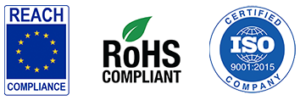If you’ve ever seen the inside of any modern electronic device, you’ll see the inner workings of advanced technologies held together with state-of-the-art adhesives. These adhesives are designed to help maintain the electrical current throughout the device, replacing bulky bonding methods such as solder. As such, electronic manufacturers are able to produce smaller, lighter, and more reliable devices using specially formulated electrically conductive adhesives.
How Does an Electrically Conductive Adhesive Work?
Electrically conductive adhesives take the place of bulky insulated wires and molten solder used in traditional electronics. While several materials can be added to epoxy to create electrically conductive properties, Epoxyset uses a variety of silver flakes and powders for its superior conductivity, low volume resistivity, and relatively lower cost compared to gold fillers and expensive solder reflow equipment. These highly specialized silver flakes and powders are blended into the epoxy matrix to act as a bridge between components, ensuring a flow of electric current. As the epoxy cures, the embedded material form particle-to-particle contact throughout the adhesive and the adjoining substrates. This contact allows the electric current to flow through the adhesive between components.
The degree of conductivity (measured as volume resistivity) is dependent on the type, size, shape and processing of the fillers. These parameters create adhesives with different volume resistivities. The lower the adhesive’s volume resistivity, the higher its electrical conductivity. In some cases, the directional flow of the current can also be controlled through specialized fillers, thus limiting the flow to a single direction.
Conductive epoxy adhesives, used in electronic manufacturing, can also act as EMI/RFI (electromagnetic interference/radio frequency interference) shielding. For EMI/RFI, a continuous cover around components prevents stray emissions from affecting other electronics.
Electrically conductive adhesives also have high thermal conductivity properties, which help regulate the heat generated during operation, protecting heat-sensitive components.
Innovation in Action
The high bond strength of epoxy, combined with the electrical conductivity of silver, make electrically conductive adhesive a viable alternative to solder and perfect for heat-sensitive applications in integrated circuit packaging, including but not limited to:
- Die Attach
- Chip Bonding
- Transistors
- Wire bond encapsulation
- LED attachments
- Semiconductor
- Microelectronics
- Optoelectronics
Electrically conductive adhesives are helping streamline electronic devices, allowing manufacturers greater opportunities to reduce material requirements, improve reliability, and spearhead innovation. For more information, please contact the experts at Epoxyset today!


